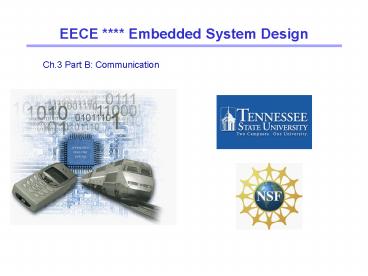EECE Embedded System Design - PowerPoint PPT Presentation
1 / 19
Title:
EECE Embedded System Design
Description:
Department of Electrical and Computer Engineering ... Bus guardian protects the system against failing processors, e.g. so-called 'babbling idiots' ... – PowerPoint PPT presentation
Number of Views:25
Avg rating:3.0/5.0
Title: EECE Embedded System Design
1
EECE Embedded System Design
2
Communication
3
CommunicationHierarchy
- Inverse relation between volume and urgency
quite common
Sensor/actuator busses
4
Communication- Requirements -
- Real-time behavior
- Efficient, economical(e.g. centralized power
supply) - Appropriate bandwidth and communication delay
- Robustness
- Fault tolerance
- Maintainability
- Diagnosability
- Security
- Safety
5
Basic techniquesElectrical robustness
- Single-ended vs. differential signals
Voltage at input of Op-Amp positive ? '1'
otherwise ? '0'
Combined with twisted pairs Most noise added to
both wires.
6
Evaluation
- Advantages
- Subtraction removes most of the noise
- Changes of voltage levels have no effect
- Reduced importance of ground wiring
- Higher speed
- Disadvantages
- Requires negative voltages
- Increased number of wires and connectors
- Applications
- USB, FireWire, ISDN
- Ethernet (STP/UTP CAT 5 cables)
- differential SCSI
- High-quality analog audio signals
7
Real-time behavior
- Carrier-sense multiple-access/collision-detection
(CSMA/CD, Standard Ethernet) no guaranteed
response time. - Alternatives
- token rings, token busses
- Carrier-sense multiple-access/collision-avoidance
(CSMA/CA) - WLAN techniques with request preceding
transmission - Each partner gets an ID (priority). After each
bus transfer, all partners try setting their ID
on the bus partners detecting higher ID
disconnect themselves from the bus. Highest
priority partner gets guaranteed response time
others only if they are given a chance.
8
Other basic techniques
- Fault toleranceerror detecting and error
correcting bus protocols - Privacyencryption, virtually private networks
9
Sensor/actuator busses
- Sensor/actuator busses Real-time behavior very
important different techniques
Many wires less wires
expensive flexible
10
Field busses Profibus
- More powerful/expensive than sensor interfaces
mostly serial. Emphasis on transmission of small
number of bytes. - Examples
- Process Field Bus (Profibus) Designed for
factory and process automation.Focus on safety
comprehensive protocol mechanisms.Claiming 20
market share for field busses.Token
passing.?93.75 kbit/s (1200 m)1500 kbits/s
(200m)12 Mbit/s (100m)Integration with
Ethernet via Profinet.
11
Controller area network (CAN)
- 2. Controller area network (CAN)
- Designed by Bosch and Intel in 1981
- used in cars and other equipment
- differential signaling with twisted pairs,
- arbitration using CSMA/CA,
- throughput between 10kbit/s and 1 Mbit/s,
- low and high-priority signals,
- maximum latency of 134 µs for high priority
signals, - coding of signals similar to that of serial
(RS-232) lines of PCs, with modifications for
differential signaling. - See //www.can.bosch.com
12
Time-Triggered-Protocol (TTP)
- The Time-Triggered-Protocol (TTP) Kopetz et
al.for fault-tolerant safety systems like
airbags in cars.
13
FlexRay
- FlexRay developed by the FlexRay
consortium(BMW, Ford, Bosch, DaimlerChrysler,
General Motors, Motorola, Philips).Combination
of a variant of the TTP and the Byteflight
Byteflight Consortium, 2003 protocol.Specified
in SDL. - Improved error tolerance and time-determinism
- Meets requirements with transfer rates gtgt CAN
std.High data rate can be achieved - initially targeted for 10Mbit/sec
- design allows much higher data rates
- TDMA (Time Division Multiple Access)
protocolFixed time slot with exclusive access
to the bus
14
TDMA in FlexRay
- Cycle subdivide into a static and a dynamic
segment.Exclusive bus access enabled for short
time in each case.Dynamic segment for
transmission of variable length
information.Bandwidth used when it is actually
needed.
15
Structure of Flexray networks
- Bus guardian protects the system against failing
processors, e.g. so-called babbling idiots
16
Other field busses
- MAPMAP is a bus designed for car factories.
- EIBThe European Installation Bus (EIB) is a bus
designed for smart homes. European Installation
Bus (EIB)Designed for smart buildings CSMA/CA
low data rate. - IEEE 488 Designed for laboratory equipment.
- Attempts to use standard Ethernet.However,
timing predictability remains a serious issue.
17
Wireless communication
18
Wireless communication Examples
- IEEE 802.11 a/b/g
- UMTS
- DECT
- Bluetooth
19
Wireless communication Example HomeRF
Competes with different extensions to IEEE 802.11
Focus on integrating phone connections. Incorporat
es DECT.































